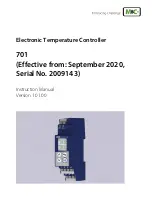
CAN
CX8050, CX8051 - Embedded-PCs for
CANopen and CAN
68
Version: 1.4
Pre-Operational
After initialization the Bus Coupler goes automatically (i.e. without the need for any external command) into
the
Pre-Operational
state. In this state it can be configured, since the service data objects (SDOs) are
already active. The process data objects, on the other hand, are still locked.
Operational
In the
Operational state
the process data objects are also active.
If external influences (such as a CAN error, or absence of output voltage) or internal influences (such as a K-
Bus error) mean that it is no longer possible for the Bus Coupler to set outputs, to read inputs or to
communicate, it attempts to send an appropriate emergency message, goes into the fault state, and thus
returns to the
Pre-Operational
state. In this way the NMT status machine in the network master can also
immediately detect fatal errors.
Stopped
In the
Stopped state
(formerly:
Prepared
) data communication with the Coupler is no longer possible - only
NMT messages are received. The outputs go into the fault state.
State Transitions
The network management messages have a very simple structure: CAN identifier
0
, with two bytes of data
content. The first data byte contains what is known as the command specifier (cs), and the second data byte
contains the node address, the node address
0
applying to all nodes (broadcast).
11 bit
identifier
2 bytes of user data
0x00
cs
Node-ID
The following table gives an overview of all the CANopen state transitions and the associated commands
(command specifier in the NMT master telegram):
Status transition
Command Specifier cs Explanation
(1)
- The initialization state is reached
automatically at power-up
(2)
- After initialization the pre-
operational state is reached
automatically - this involves
sending the boot-up message.
(3), (6)
cs = 1 = 0x01 Start_Remote_Node.
Starts the module, enables outputs,
starts transmission of PDOs.
(4), (7)
cs = 128 = 0x80 Enter_Pre-Operational. Stops PDO
transmission, SDO still active.
(5), (8)
cs = 2 = 0x02 Stop_Remote_Node.
Outputs go into the fault state,
SDO and PDO switched off.
(9), (10), (11)
cs = 129 = 0x81 Reset_Node. Carries out a reset.
All objects are reset to their power-
on defaults.
(12), (13), (14)
cs = 130 = 0x82 Reset_Communication. Carries out
a reset of the communication
functions. Objects 0x1000 -
0x1FFF are reset to their power-on
defaults.
Example 1
The following telegram puts all the modules in the network into the error state (outputs in a safe state):
Summary of Contents for CX8050
Page 2: ......
















































